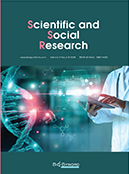Abstract
Schizophrenia is a severe mental disorder affecting patients’ cognition, perception, emotion, linguistics,
behavior, and sense of self. Both early detection and interventions are crucial for treatment outcomes. Furthermore, the causes of schizophrenia remain uncertain, with identified links to hereditary, brain chemistry, and physiological factors. This article presents a case study of a young Chinese woman diagnosed with schizophrenia, highlighting the potential influence of environmental exposures as an additional factor. The article also examines the impact of public knowledge on perpetuating stigma around psychosis and its effects on treatment efficacy.
References
World Health Organization, 2022, Schizophrenia, viewed July 1, 2023, https://www.who.int/en/news-room/factsheets/detail/schizophrenia
Opare-Addo MN, Mensah J, Aboagye GO, 2020, A Case of Schizophrenia in a Young Male Adult with No History of Substance Abuse: Impact of Clinical Pharmacists’ Interventions on Patient Outcome. Case Reports in Psychiatry, 2020: 3419609. https://doi.org/10.1155/2020/3419609
Tandon R, Gaebel W, Barch DM, et al., 2013, Definition and Description of Schizophrenia in the DSM-5. Schizophrenia Research, 150(1): 3–10.
Gearing RE, Chen W, Kathryne B, et al., 2022, Examining public stigma of schizophrenia in China, China Journal of Social Work. https://doi.org/10.1080/17525098.2022.2079164
Howes OD, McDonald C, Cannon M, et al., 2004, Pathways to Schizophrenia: The Impact of Environmental Factors. International Journal of Neuropsychopharmacology, 7(Suppl 1): S7–S13.
Arnold SE, 1999, Neurodevelopmental Abnormalities in Schizophrenia: Insights from Neuropathology. Development and psychopathology, 11(3): 439–456.
Pickard B, 2011, Progress in Defining the Biological Causes of Schizophrenia. Expert Reviews in Molecular Medicine, 13: e25, https://doi.org/10.1017/S1462399411001955
Tsuang M, 2000, Schizophrenia: Genes and Environment. Biological Psychiatry, 47(3): 210–220.
Keshavan MS, Tandon R, Boutros NN, et al., 2008, Schizophrenia,“Just the Facts”: What We Know in 2008, Part 3: Neurobiology. Schizophrenia Research, 106(2–3): 89–107.
M’Barek L, Mercy G, Gautier C, et al., 2022, Frontal Lobe Functions in Schizophrenia: Interest of the Stuss Approach. Brain and Cognition, 160: 105878. https://doi.org/10.1016/j.bandc.2022.105878.
Gomes FV, Zhu X, Grace AA, 2019, Stress During Critical Periods of Development and Risk for Schizophrenia. Schizophrenia Research, 213: 107–113. https://doi.org/10.1016/j.schres.2019.01.030.
Moustafa AA, Tindle R, Frydecka D, et al., 2017, Impulsivity and its Relationship with Anxiety, Depression and Stress. Comprehensive Psychiatry, 74: 173–179, https://doi.org/10.1016/j.comppsych.2017.01.013
Freud S, Kistner U, Haute P, et al., 2017, Three Essays on the Theory of Sexuality: The 1905 Edition, Verso Books, London.
Häfner H, 2000, Onset and Early Course as Determinants of the Further Course of Schizophrenia. Acta Psychiatrica Scandinavica, 102(s407): 44–48.
Jorm AF, 2000, Mental Health Literacy: Public Knowledge and Beliefs about Mental Disorders. The British Journal of Psychiatry, 177(5): 396–401.
